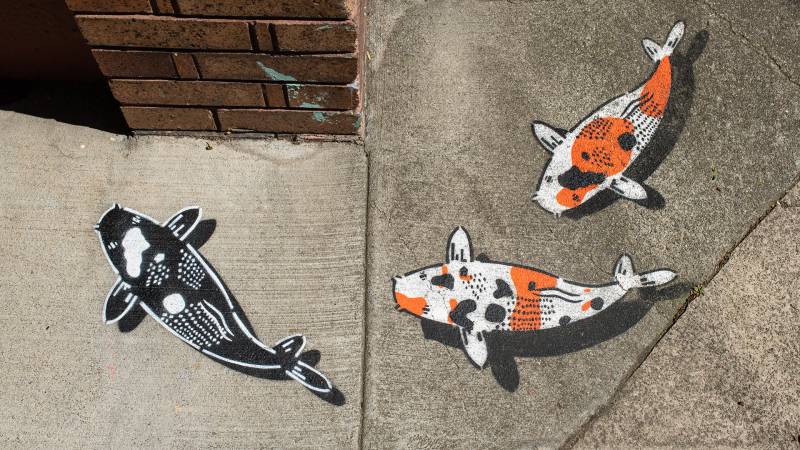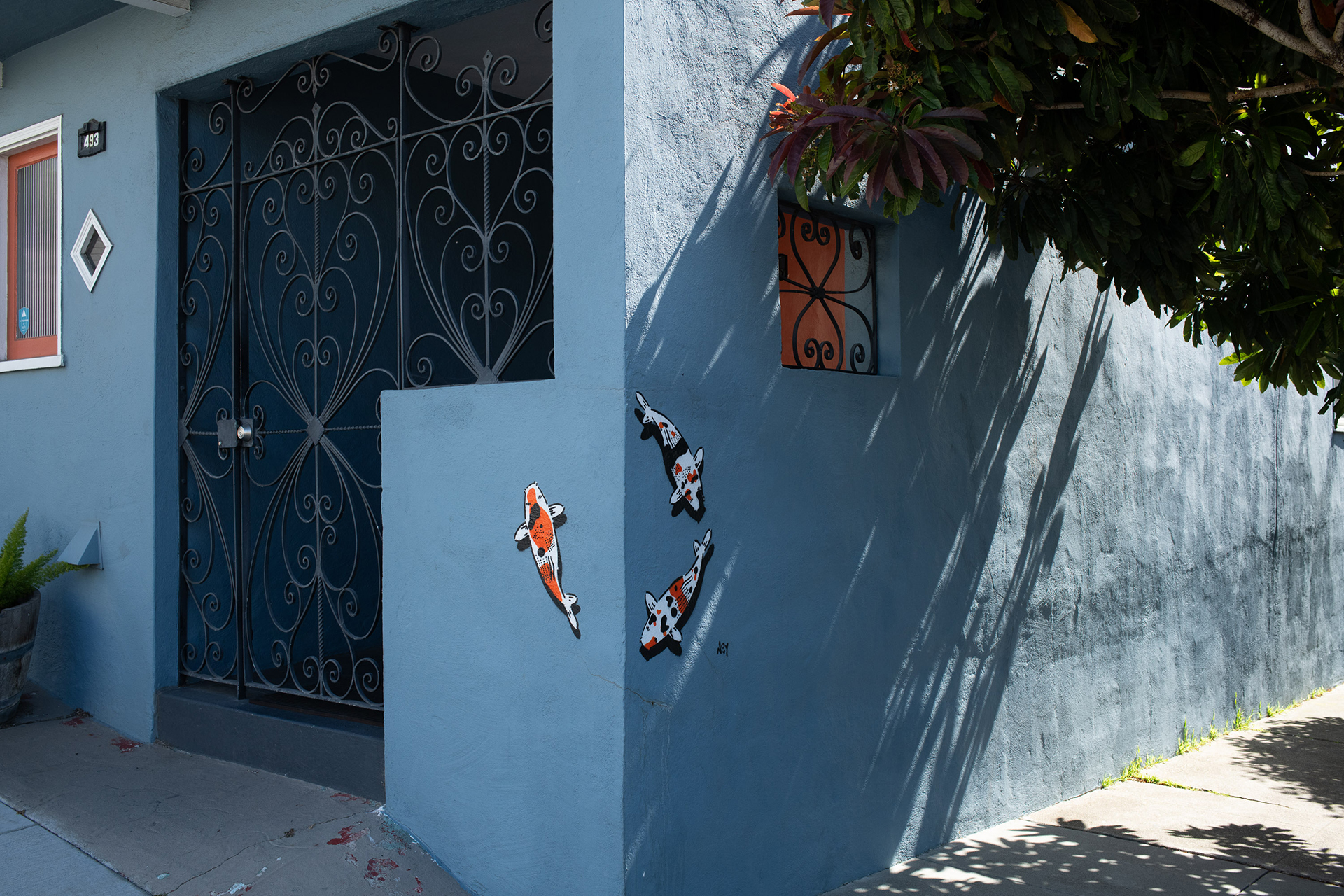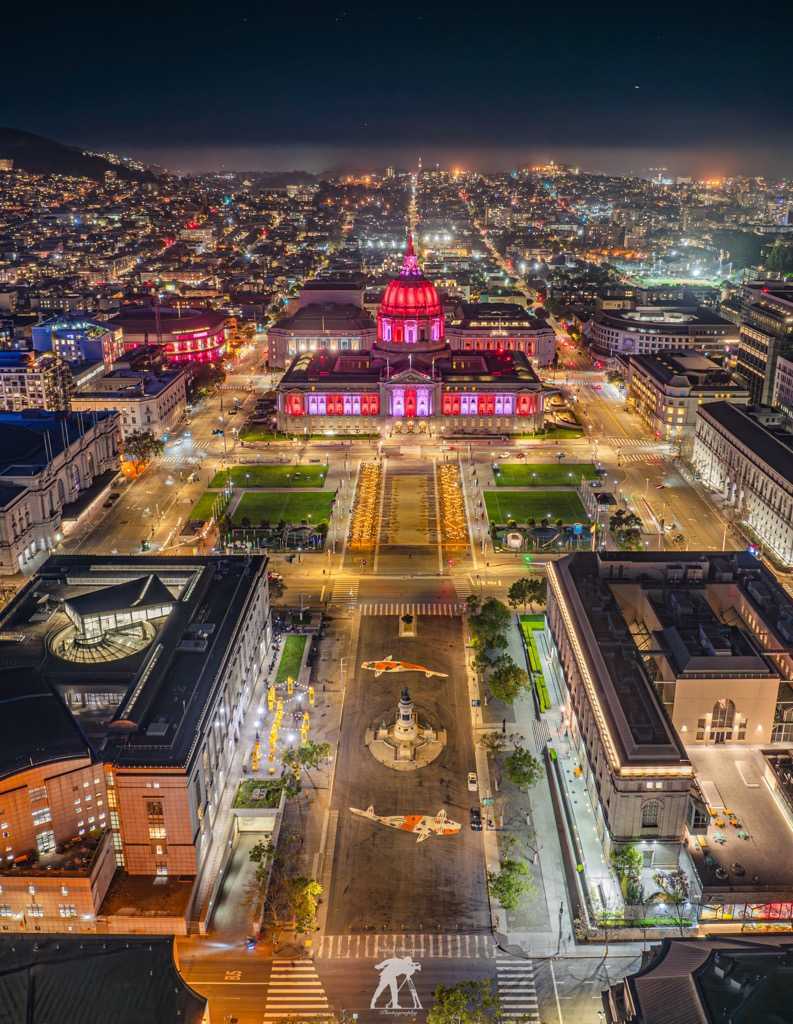Episode Transcript
Olivia Allen-Price: Wander around the Bay Area long enough, and you are certain to stumble upon one of our most ubiquitous pieces of street art. Schools of playful, graphic koi fish swimming through our urban landscape.
Music begins
Layf Kutschera: Maybe the first one I saw was near my house. I’ve lived in two places in San Francisco, and both of them have a koi-like right outside the door. My name is Layf Kutschera. And I am an interior designer and watercolor artist here in San Francisco.
Olivia Allen-Price: Soon after Layf noticed the koi for the first time, he started seeing them everywhere — usually on sidewalks but sometimes on buildings. They’re anywhere for a few inches to a few feet long. And their colors? High contrast…
Layf Kutschera: Vibrant orange, white, black
Olivia Allen-Price: Layf wrote into Bay Curious, wanting to know the backstory behind these fish, which seem to be spawning all over the place. So today on the show, we’ll meet the person behind them, learn what inspired the koi and decode the hidden message within each design. I’m Olivia Allen-Price. We’ll be right back.
SPONSOR
MESSAGE
Olivia Allen-Price: For our question asker Layf Kutschera, the koi stencils often spotted in our region have become a delight
Layf Kutschera: I think it’s just great to see color in our gray cityscape. Once you see one, you kind of keep an eye out for other ones, and then they become a little treat!
Olivia Allen-Price: They’re also a treat for Tamuna Chkareuli, a journalism fellow from the Republic of Georgia. She’s been embedded with the Bay Curious team for the last three weeks. She’ll take the story from here…
Sound from a street in San Francisco
Tamuna Chkareuli: I couldn’t relate more to our question-asker. It was my first week in San Francisco when I saw 2-foot-long bright orange koi fish stenciled on my street. Then, I saw three more on my morning run. Suddenly, the city was full of hidden ponds! I started to see them everywhere. To me, they felt like a warm welcome in a new place. And these koi swam a really long way to be here — all the way from China.
Music begins
Jeremy Novy: I got to travel around a lot of China, see a lot of really interesting things that definitely had an influence and an impact on my life. My name is Jeremy Novy. I’m a stencil street artist.
Tamuna Chkareuli: Jeremy has been working in the Bay Area for sixteen years, but the inspiration behind his art goes back decades to the Cultural Revolution in China, which started in 1966.
Music ends
Jeremy Novy: China was told to destroy the old to make way for the new, which meant getting rid of, like, feng shui ideas. And so they became, kind of kind of scared that their history would be lost forever. So they devised a plan that they were going to hide Chinese lucky numbers in koi paintings.
Tamuna Chkareuli: Jeremy releases his koi to the ponds of concrete in groups. He’ll paint anywhere from one koi fish to as many as nine. And just like in China, there’s a hidden meaning behind the number of koi Jeremy paints.
Sound of flowing water begins.
Jeremy Novy: One symbolizes perseverance, overcoming obstacles and strength. There’s a story of a koi that spent 90 years trying to jump up a waterfall, and it finally jumped up the waterfall, and the gods appeased it by turning it into the Asian water dragon.
Sparkley sound effect. Water sound fades.
Jeremy Novy: Two symbolizes double happiness or good things come in pairs. And who doesn’t want to be happy? Not once, but over and over again. Three represents the three stages of life: birth, marriage and death.
Tamuna Chkareuli: You’re unlikely to see four koi fish painted together. Four is a forbidden number in Chinese, a symbol of death, so he usually skips it.
Jeremy Novy: Five symbolizes transformation, the story of an emperor coming from peasantry and walking through five gates before becoming emperor. The last one being that of the Forbidden City.
Music begins
Tamuna Chkareuli: And for that reason, a group of five koi is special for Jeremy. It is the transformation he identifies with.
Jeremy Novy: If it wasn’t for street art, I think that I would be a little bit lost in life. It’s been a place for me to put my depression, my anxiety and my stress. And it’s been a way for me to communicate with people in a very beautiful way.
Tamuna Chkareuli: Six koi is about entrepreneurship and business. Seven — about the community. If you ever see eight koi swirling around on the sidewalk, it’s your lucky day.
Music fades
Jeremy Novy: And nine represents the universe and everything in it, including all of the other eight lucky numbers.
Music begins
Tamuna Chkareuli: The colors Jeremy uses have meaning too. Black absorbs all the negativity, so if you had a bad day and see a black koi — go stand on it! Golden koi are the money fish that bring prosperity into your life. And orange is a nod to the state flower, the California poppy, and the San Francisco Giants.
Music ends
Tamuna Chkareuli: Jeremy started painting koi in 2008, and he has lost count of how many are out there, but he says there must be at least 8,000 of them all over the Bay Area. He still remembers the first one he made.
Jeremy Novy: It was exactly across the street from the Women’s Center on 18th Street. I stenciled them there because I really thought that the mural at the Women’s Center was a very beautiful thing. I was very fascinated with some of the symbolism and the empowerment of women that is found in that mural.
Music begins
Tamuna Chkareuli: From hidden alleyways, the koi swam to more open waters. This year, Jeremy and a team of volunteers painted two whale-sized koi in Fulton Plaza, right near City Hall. It was a lot of work. They made a grid of 5-foot squares, and Jeremy painted koi in those sections, using primer, exterior paint and a sealant. Those koi also carry tiny reflective glass beads in them, like what’s used in lane markings on the highway, so the fish can glow when the light hits them.
Jeremy Novy: It’s kind of amazing. It somehow feels that, like, what I’m doing is right. And I’ve, before, had to deal with concern about the police arresting me for doing my art without permission. So it feels very nice that people have recognized what I’m doing as being an important part of the art community and art history.
Tamuna Chkareuli: Once a secretive project, Jeremy’s koi are now a common sight in public spaces. He says that his art is not there to take over the area or make a statement.
Jeremy Novy: Art is a therapeutic experience for those who make it, but it’s also a hugely therapeutic experience for people that see it. And not everybody has money and galleries to experience art. Whenever I put them out there, it’s just about trying to bring peace to people’s daily life and a little bit of comfort.
Tamuna Chkareuli: Just like the real koi in a pond would do.
Music ends, signaling the end of the story.
Olivia Allen-Price: What I love about this story, Tamuna, is that I’ve been seeing these koi all over the Bay Area for years and never knew the meaning behind them. And now I’m going to see them in a whole new light. I cannot wait until the next time I stumble upon them on the street.
Tamuna Chkareuli: So Jeremy did commissions during the pandemic when people could just call him and commission to have koi painted in front of their house. So now, when I see koi in front of somebody’s porch, I’m wondering why they picked this number.
Olivia Allen-Price: Ooo! Now, if you were to get a commissioned piece, which number would you pick?
Tamuna Chkareuli: I would go with one. About perseverance.
Olivia Allen-Price: Mmm! Why?
Tamuna Chkareuli: I think there’s a water dragon inside me.
Olivia Allen-Price: (laughing) I love that. Tamuna Chkareuli, thank you so much for this story and for part of the Bay Curious team these past three weeks!
Tamuna Chkareuli: I had a blast. Thanks for having me!
Music
Olivia Allen-Price: Big thanks to Leif Kutschera for asking this week’s question. If you’ve got a question you’d like to hear answered on Bay Curious, head to BayCurious.org and ask! While you’re there, sign up for our monthly newsletter, where we often answer even more listener questions than we can get to on the podcast. Again, it’s all at BayCurious.org.
Olivia Allen-Price: This week, we’d like to offer a special shout-out to our listener, Cassie. Hope you have a magical birthday! From your friend, Ashley.
Olivia Allen-Price: The Bay Curious team is taking a breather next week for Memorial Day, so we will not be releasing an episode. But I hope you will listen to our back catalog. There are so many hidden gems in there. So go check it out. We’ll be back the first week of June.
Olivia Allen-Price: Bay Curious is made in San Francisco at member-supported KQED. This show was edited by me, Olivia Allen-Price.
Pauline Bartolone: Produced by me, Pauline Bartolone…
Everyone saying their own names: …Tamuna Chkareuli, Katrina Schwartz and Christopher Beale.
Paul Lancour: Additional support from Paul Lancour….
Everyone saying their own names: Lusen Mendel, Jen Chien, Katie Sprenger, Cesar Saldana, Maha Sanad, Xorje Olivares, Holly Kernan …



